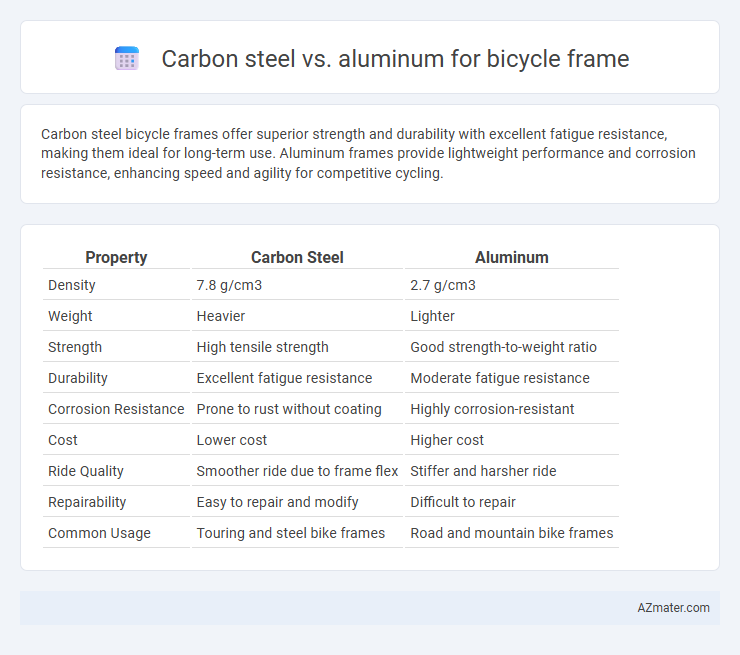Carbon steel bicycle frames offer superior strength and durability with excellent fatigue resistance, making them ideal for long-term use. Aluminum frames provide lightweight performance and corrosion resistance, enhancing speed and agility for competitive cycling.
Table of Comparison
| Property | Carbon Steel | Aluminum |
|---|---|---|
| Density | 7.8 g/cm3 | 2.7 g/cm3 |
| Weight | Heavier | Lighter |
| Strength | High tensile strength | Good strength-to-weight ratio |
| Durability | Excellent fatigue resistance | Moderate fatigue resistance |
| Corrosion Resistance | Prone to rust without coating | Highly corrosion-resistant |
| Cost | Lower cost | Higher cost |
| Ride Quality | Smoother ride due to frame flex | Stiffer and harsher ride |
| Repairability | Easy to repair and modify | Difficult to repair |
| Common Usage | Touring and steel bike frames | Road and mountain bike frames |
Introduction to Bicycle Frame Materials
Carbon steel offers high tensile strength and excellent shock absorption, making it durable and comfortable for bicycle frames. Aluminum is lightweight and corrosion-resistant, providing better speed and agility due to its lower density. Both materials serve distinct purposes in bicycle manufacturing, with carbon steel favoring strength and ride quality, while aluminum emphasizes weight savings and rust resistance.
Overview of Carbon Steel and Aluminum
Carbon steel offers high tensile strength and durability with excellent shock absorption, making it a preferred choice for affordable and sturdy bicycle frames. Aluminum frames are lightweight, corrosion-resistant, and provide efficient power transfer, favored for racing and performance-oriented bikes. Both materials have distinct mechanical properties that influence ride quality and frame longevity.
Weight Comparison: Carbon Steel vs Aluminum Frames
Carbon steel bicycle frames typically weigh more than aluminum frames due to the higher density of steel (7.85 g/cm3) compared to aluminum (2.70 g/cm3). Aluminum frames offer significant weight savings, often 1 to 3 pounds lighter, making them preferred for performance and racing bikes. However, carbon steel provides enhanced durability and ride comfort despite the increased weight.
Strength and Durability Analysis
Carbon steel offers superior tensile strength and excellent fatigue resistance, making it highly durable for bicycle frames under repetitive stress. Aluminum is lighter but less impact-resistant, prone to fatigue over time, and may develop micro-cracks, reducing frame longevity. Steel's corrosion resistance can be enhanced with coatings, while aluminum's natural oxide layer provides some protection, though both require maintenance for optimal durability.
Ride Quality and Comfort Differences
Carbon steel bicycle frames offer superior ride quality due to their natural vibration-damping properties, providing a smoother and more comfortable experience on rough terrain. Aluminum frames, while lighter and stiffer, tend to transmit more road shock and vibrations to the rider, which can result in a harsher ride over long distances. Cyclists prioritizing comfort and shock absorption often prefer carbon steel frames for endurance riding, whereas aluminum is favored for its lightweight and responsive handling despite sacrificing some ride comfort.
Cost Effectiveness and Affordability
Carbon steel bicycle frames offer superior cost effectiveness and affordability due to their lower material and manufacturing expenses compared to aluminum. Steel frames are often easier to repair and maintain, reducing long-term costs for riders seeking durable and budget-friendly options. Aluminum frames, while lightweight and corrosion-resistant, generally come at a higher initial price point, making carbon steel the preferred choice for economical cycling enthusiasts.
Corrosion Resistance and Maintenance
Carbon steel bicycle frames offer moderate corrosion resistance but require regular maintenance, such as applying protective coatings or paint to prevent rusting in humid or wet conditions. Aluminum frames exhibit superior corrosion resistance due to their natural oxide layer, reducing the need for frequent upkeep and making them ideal for riders seeking low-maintenance options. Choosing aluminum frames minimizes long-term maintenance costs while carbon steel frames demand consistent care to maintain durability and aesthetic appeal.
Customization and Design Flexibility
Carbon steel offers unparalleled customization and design flexibility for bicycle frames due to its excellent weldability and ability to be shaped into intricate geometries, allowing manufacturers to tailor frame stiffness and ride characteristics precisely. Aluminum frames provide moderate design flexibility with advanced welding and hydroforming techniques but are generally less adaptable to complex custom modifications compared to carbon steel. The choice between carbon steel and aluminum greatly influences the extent of personalized frame designs, impacting rider comfort, weight distribution, and aesthetic appeal.
Environmental Impact and Sustainability
Carbon steel bicycle frames exhibit higher recyclability and lower embodied energy compared to aluminum, making them more environmentally sustainable over their lifecycle. Aluminum production involves energy-intensive processes and contributes to significant greenhouse gas emissions, though aluminum frames offer durability and corrosion resistance which can extend product lifespan. Choosing carbon steel supports reduced resource extraction and promotes circular economy practices in the cycling industry due to its ease of repair and recyclability.
Choosing the Right Material for Your Riding Style
Carbon steel offers exceptional durability and a smooth ride, ideal for riders seeking comfort and strength on varied terrains. Aluminum frames are lightweight and provide faster acceleration, making them perfect for speed-focused cyclists and road racing enthusiasts. Selecting the right material depends on your priority: steel suits long-distance touring and rough conditions, while aluminum excels in competitive, performance-driven cycling.

Infographic: Carbon steel vs Aluminum for Bicycle frame
 azmater.com
azmater.com